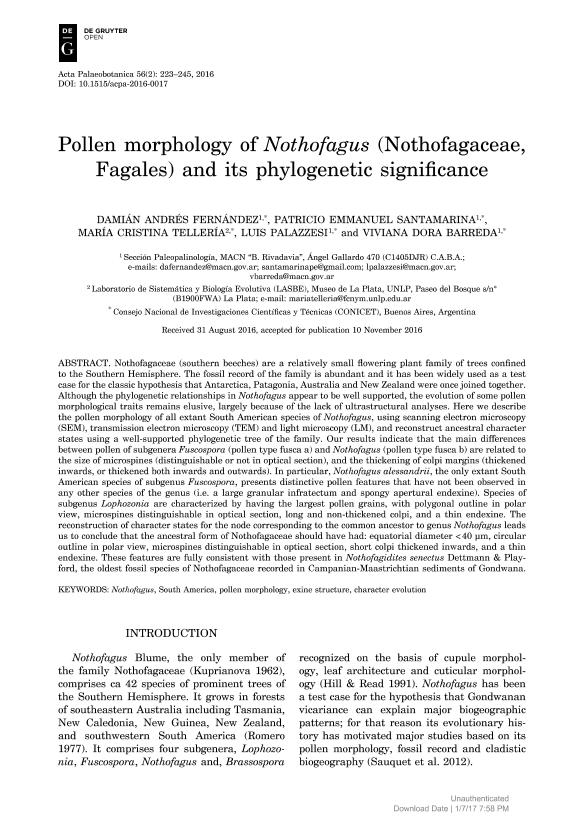Artículo
Pollen morphology of Nothofagus (Nothofagaceae, Fagales) and its phylogenetic significance
Fernández, Damián Andrés ; Santamarina, Patricio Emmanuel
; Santamarina, Patricio Emmanuel ; Tellería, María Cristina
; Tellería, María Cristina ; Palazzesi, Luis
; Palazzesi, Luis ; Barreda, Viviana Dora
; Barreda, Viviana Dora
 ; Santamarina, Patricio Emmanuel
; Santamarina, Patricio Emmanuel ; Tellería, María Cristina
; Tellería, María Cristina ; Palazzesi, Luis
; Palazzesi, Luis ; Barreda, Viviana Dora
; Barreda, Viviana Dora
Fecha de publicación:
12/2016
Editorial:
De Gruyter
Revista:
Acta Palaeobotanica
e-ISSN:
2082-0259
Idioma:
Inglés
Tipo de recurso:
Artículo publicado
Clasificación temática:
Resumen
Nothofagaceae (southern beeches) are a relatively small flowering plant family of trees confined to the Southern Hemisphere. The fossil record of the family is abundant and it has been widely used as a test case for the classic hypothesis that Antarctica, Patagonia, Australia and New Zealand were once joined together. Although the phylogenetic relationships in Nothofagus appear to be well supported, the evolution of some pollen morphological traits remains elusive, largely because of the lack of ultrastructural analyses. Here we describe the pollen morphology of all extant South American species of Nothofagus, using scanning electron microscopy (SEM), transmission electron microscopy (TEM) and light microscopy (LM), and reconstruct ancestral character states using a well-supported phylogenetic tree of the family. Our results indicate that the main differences between pollen of subgenera Fuscospora (pollen type fusca a) and Nothofagus (pollen type fusca b) are related to the size of microspines (distinguishable or not in optical section), and the thickening of colpi margins (thickened inwards, or thickened both inwards and outwards). In particular, Nothofagus alessandrii, the only extant South American species of subgenus Fuscospora, presents distinctive pollen features that have not been observed in any other species of the genus (i.e. a large granular infratectum and spongy apertural endexine). Species of subgenus Lophozonia are characterized by having the largest pollen grains, with polygonal outline in polar view, microspines distinguishable in optical section, long and non-thickened colpi, and a thin endexine. The reconstruction of character states for the node corresponding to the common ancestor to genus Nothofagus leads us to conclude that the ancestral form of Nothofagaceae should have had: equatorial diameter < 40 μm, circular outline in polar view, microspines distinguishable in optical section, short colpi thickened inwards, and a thin endexine. These features are fully consistent with those present in Nothofagidites senectus Dettmann & Playford, the oldest fossil species of Nothofagaceae recorded in Campanian-Maastrichtian sediments of Gondwana.
Archivos asociados
Licencia
Identificadores
Colecciones
Articulos(CCT - LA PLATA)
Articulos de CTRO.CIENTIFICO TECNOL.CONICET - LA PLATA
Articulos de CTRO.CIENTIFICO TECNOL.CONICET - LA PLATA
Articulos(MACNBR)
Articulos de MUSEO ARG.DE CS.NAT "BERNARDINO RIVADAVIA"
Articulos de MUSEO ARG.DE CS.NAT "BERNARDINO RIVADAVIA"
Citación
Fernández, Damián Andrés; Santamarina, Patricio Emmanuel; Tellería, María Cristina; Palazzesi, Luis; Barreda, Viviana Dora; Pollen morphology of Nothofagus (Nothofagaceae, Fagales) and its phylogenetic significance; De Gruyter; Acta Palaeobotanica; 56; 2; 12-2016; 223-245
Compartir
Altmétricas



